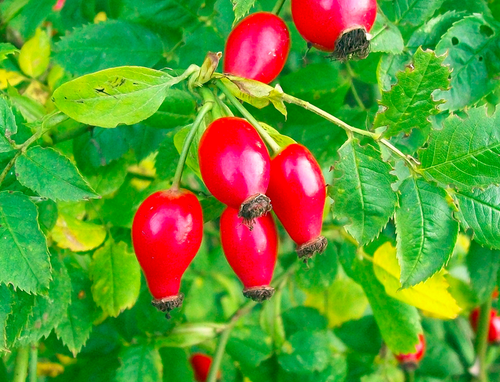
Rosehip, also spelled rose hip or rose-hip, and also known as rose haw or rose hep, is a fruit from the rose plant. Rosehips require pollination of the rose bush flowers. The rosehip ripens from later summer into autumn.[1]
Rosehips have a higher level of vitamin C than citrus fruit.[2]
Most rosehips come from the wild or old-fashioned roses. The rosehips will turn bright red after being left on the rosebush for the first frost.[2] They become softer with the first frost, which is desirable.
Culinary use of rosehips
Rosehips have many culinary uses, both when fresh and when dried. One typical example of using roesehips is to make rosehip jelly or jam. Other uses for rosehips in a culinary way include rosehip soup, inside fruit pies, as puree, and as a syrup or sauce.[2]
Rosehips are also useful in beverages, including rosehip tea, rosehip wine and rosehip summer drinks.
If eaten raw, care must be taken to avoid the hairs inside the fruit, as these are itchy.
To prepare rosehips for cooking or eating:[2] Trim the blossom and stem ends off using a knife or scissors. Cut the rosehip in half down its length and use a small spoon to remove both hairs and seeds inside the rosehip. Discard of these and rinse the fruit.
Caution: Rosehips should only be consumed from safe sources. If you don't know whether or not a rose bush has had food-safe pesticide applied to it, do not use the rosehips. As long as you're certain the rosebush is either organic or has only been treated with food-safe pesticide, then the rosehips can be used. Note also that not all rosehips are good to eat; your taste buds will tell you.
Drying rosehips
Prepare the rosehips as outlined above. Set out in single layers in a dehydrator or place on a screen and place in the oven to dry at its lowest setting.[2] The rosehips can also be dried on mesh screens in a dark and dry place with adequate airflow.
Once dried thoroughly, store in airtight containers until needed. Keep them in cool and dark storage.
Other uses for rosehips
Rosehips can be used in nature crafts, such as for decorating a craft item, adding to potpourris, used as a fragrance or added to wreaths.
Medicinal uses needs to be covered, with appropriate referencing. For example, rosehip may have a role to play in reducing blood pressure, cholesterol and improvement of heart health in the obese - see U Anderson. Effects of rose hip intake on risk markers of type 2 diabetes and cardiovascular disease: a randomized, double-blind, cross-over investigation in obese persons. European Journal of Clinical Nutrition advance online publication 14 December 2011; doi: 10.1038/ejcn.2011.203. http://www.nature.com/ejcn/journal/vaop/ncurrent/abs/ejcn2011203a.html